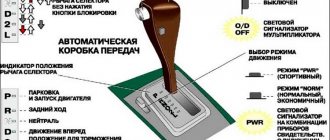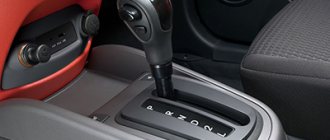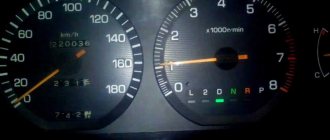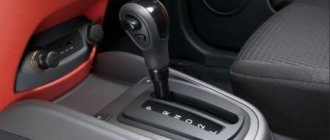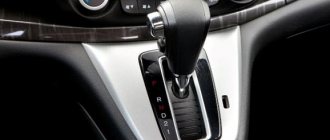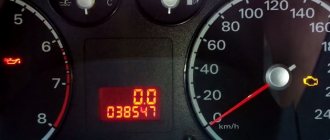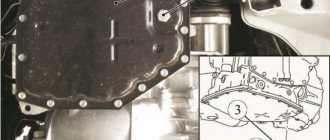As you know, torque from the engine is transmitted to the transmission. In this case, the transmission of torque on cars with manual transmission occurs through the clutch mechanism. Clutch is also present in robotic gearboxes. As for automatic transmissions, owners of such cars are often interested in whether there is a clutch on the automatic transmission, how it works, when to change the automatic transmission clutch, etc.
In this article, we will look at how the transmission of torque from the power unit is implemented in cars with an automatic transmission, as well as what features and differences of the clutch on an automatic transmission can be distinguished in comparison with a manual or manual transmission.
Is there an automatic clutch? Let's look at the technical component
Many drivers who switched from manual to automatic (by the way, this lesson will be useful) ask a seemingly simple but significant question - does an automatic transmission have a clutch?
Or does it not exist there at all? And how then do the gears change... ARTICLE CONTENTS
Of course, the average person, accustomed to driving “strictly” with a manual transmission, does not really like the automatic transmission. For his reasons, this is a really unreliable unit, but yes, a manual transmission! For centuries. But the mechanics have a not very strong unit, especially for beginners, this is the clutch, which fails “on time”. Let us recall a little the principle of operation of a mechanical “box”
- Mechanics
- Machine
- version - I recommend!!!
Of course, the average person, accustomed to driving “strictly” with a manual transmission, does not really like the automatic transmission.
For his reasons, this is a really unreliable unit, but yes, a manual transmission! For centuries.
But the mechanics have a not very strong unit, especially for beginners, this is the clutch, which fails “on time”. Let us recall a little the principle of operation of a mechanical “box”
Mechanics
As we remember, there are three pedals, if you go from right to left - the first is “gas”, the middle is “brake” and the outermost is “clutch”.
In order for you to get going, you need to squeeze the clutch into gear, then releasing this pedal, press on the gas and the car goes.
When changing gears, you also need to repeat this procedure.
The design is very simple - if you like, it is based on dry friction of discs.
To exaggerate, under the action of its springs, the driven one is rigidly pressed against the driving disk, due to which the car moves.
But as soon as you press the pedal, the discs unclench (move away from each other) and you can change gears (up, down, or neutral).
This design has been working for a century, and it is indeed durable, but for beginners it is not an easy test. Often they simply overexert the pedals when switching - the discs rub and the less durable one wears out.
After such abrasion, there is no longer a strong connection (pressure), the disks begin to slip, and therefore the car loses dynamics during acceleration and just driving (if the disk is completely “killed”, it may not move, just don’t switch).
We remembered a little, but what about automatically?
Machine
We reveal the main secret - there is no clutch in the classical sense, on an automatic transmission - of course! There are no two dry discs that interact with each other, but the principle of releasing gears is still present here. That is, there is a clutch, but it is automated, completely different.
Let's now remember how we change gears here (after all, there are only two pedals) - we simply press the brake, move the automatic transmission knob to position D (drive), release the pedal and press the gas - the car starts moving. But what is the principle?
You know, I may disappoint many fans of mechanics, but the automatic machine is also no less “ancient”, it is about to turn 100 years old.
Here, too, everything is banal and simple, the basis for the operation of such a transmission is a torque converter and, unlike a manual transmission, here the clutch operates due to fluid - transmission oil, that is, as it were - a wet type.
If we exaggerate the principle of operation, imagine two fans that operate opposite each other, as close as possible.
If one rotates, then it will transmit the air flow to the other, and depending on the speed, it will also take on one or another rotation speed, this is the torque converter.
There are two turbines here, one driving - the second driven, they are placed in a viscous liquid (oil) and closed in a sealed housing.
When one begins to rotate, it transfers vortex energy to the second, due to which movement occurs.
However, now the design has been slightly improved - after the speed of these turbines becomes the same, they are rigidly engaged with the help of special couplings, which are designed to reduce the loss of torque energy. This is the principle of a “classical” machine gun!
Many people can now - but why does it have to be oil? Yes, everything is simple, the air is weak for such speeds, it does not transfer as much energy, the water will boil faster, and will also oxidize all the metal parts inside - the resource will drop. But the oil not only transfers the maximum amount of energy, but also lubricates the spare parts inside, thereby protecting them from wear, which is why it is so important to change it on time.
Read more: CVT what is a CVT gearbox
Nowadays, torque converter automatic transmissions are installed on a wide range of cars, but it is worth noting that there are now at least three automatic transmissions - automatic, variator, robot. Both the robot and the variator have a completely different principle, but I’ll write about that some other time.
Now the video version of the article
I’ll finish this, read our AUTOBLOG.
Functional Features
Having studied the features of the location of the pedals in cars with a manual transmission, it will not be difficult to finally remember where each is. Each of you understands that the pedals in the car play a certain role. Everyone has their own strictly assigned function. And they need to be taken into account when getting behind the wheel.
Let us remind you how the pedals in any car go from left to right on the driver’s side:
- clutch;
- brake;
- gas.
In an automatic transmission, everything goes exactly the same way, but only with the condition that there is no clutch in this sequence.
To better understand the functional features, you need to consider all the pedals separately.
Clutch
It's easy to remember where the clutch lever is located in your car. It is important to take into account that on all cars they are always in the same place. Car companies cannot place the clutch on the right or in the middle.
Now let’s talk more specifically about why such a control lever in a car as a clutch pedal is needed. Responsible for the connection between the gearbox and the engine, as well as disconnection as necessary. If the pedal is not touched, the engine will be connected to the gearbox, that is, at this time the clutch is considered to be engaged.
When the control lever is pressed to the floor, disengagement occurs and therefore the clutch is disengaged. In order for the car to start moving, the driver must turn the clutch back on. And to do this, simply release the pedal.
If you take into account the design, everything happens as follows:
- the clutch disc consisting of a pair of discs is located on the splines of the input shaft of the box, a rigid connection is used;
- in this case, the disk is clamped between the motor flywheel and the basket rings;
- when the pedal is pressed, a special spring releases the ring located on the basket;
- the ring moves away from the flywheel;
- the disk is released and it begins to rotate independently of this flywheel;
- now the driver changes gear and then releases the pedal;
- at the same time, the spring is released by the release bearing, the rings come back together, and the disk is clamped again.
Clutch operation in an automatic transmission
Driving instructors teach that you can’t keep the clutch depressed for a long time on a manual transmission, and when stopping at traffic lights and in various congestions, you must always put it in neutral. What to do with an automatic transmission? If suddenly the recommendation not to hold the clutch depressed for a long time on a manual transmission seemed unclear to you, then we will explain.
When the clutch is disengaged (i.e. the pedal is depressed), the release bearing and the diaphragm spring of the clutch “basket” wear out, since together they “squeeze” the driven disk away from the drive disk, stopping the supply of torque from the motor to the box. Accordingly, the longer we keep the pedal depressed with the engine running, the sooner we will have to buy a new “basket” and release valve.
However, in reality the problem is not so significant, since the safety margin of these parts is very serious. But let’s return to automatic transmissions, with which everything is somewhat more complicated. As per tradition, let’s turn to online forums and find out what they think about this and what owners of cars with automatic transmissions usually do.
One of the most common opinions here can be summed up with the following phrase: “When I just stop at a traffic light or there is a small traffic jam, I don’t turn on neutral. If there is some serious and stationary traffic jam ahead, for example, during a railroad crossing or road work, which is obviously going to take a long time, then I switch to neutral so as not to overheat the box.”
There are also more radical statements like this: “You should never turn on any “neutral” at all - this is an “automatic”, and in general there is no need to pull the gearbox selector again. According to the experience of my friends, switching modes on an automatic machine too often leads to its rapid breakdown.”
Let's turn to the professionals. The question is explained by Trans Gear automatic transmission repairman Leonid Khentalov, who believes that every opinion has its own grain of truth. But! First, you need to divide automatic transmissions into torque converter and robotic ones. Let us briefly note that the essence of the difference lies in the types of clutch.
The classic “automatic” has a hydraulic clutch, and the “robot” is the same as on the “mechanics”, with rubbing discs. So, in robotic gearboxes there is no need to turn on “neutral” - neither in long traffic jams, nor when stopping at a traffic light. Many people believe that “at idle”, when the car does not move and the engine is running, the clutch discs in the “robot” gearbox are worn out, so it is necessary to turn on “neutral”.
It's a delusion. When the brake is applied, the actuators automatically release the clutch. It turns out to be the same story as with “mechanics” - if you stand for a long time with the gear engaged and the clutch depressed, then in theory the release bearing will wear out sooner. But not the disk, which is not involved in this situation.
As for torque converter boxes, the question is a little more complicated. Many people turn on “neutral”, not wanting to overheat the box, but do not think about what could cause the box to overheat. And this happens due to a clogged automatic transmission oil filter - it often becomes clogged with dust, sand and other road dirt.
Often the filter becomes clogged from the inside, becoming coked with deposits. In this case, turning on “neutral” when stopping at “long” traffic lights or crossings is nothing more than a way to save the box longer from a service visit. If the box filter is not clogged and the oil in it is cooled in normal mode, then there is no need to turn on “neutral” on torque converter boxes.
What is the result? Obviously, on old cars, the condition of the transmission filter is unknown, turning on “neutral” during long stops with the engine running, for example, at the same railway crossing, makes sense. This way you can delay visiting the service, save up money for repairs for some time, or (may the author be forgiven for his cynicism) sell the car.
If you bought yourself an old car and are going to drive it happily ever after, spare no expense and time to change the filter in the automatic transmission, and at the same time the oil. There are no “maintenance-free” gearboxes, no matter what they say in the instructions. Well, if you have a new car with an “automatic” or “robot”, then it makes sense to turn on “neutral” only if your foot is tired of holding the brake.
The clutch on an automatic transmission performs the same role as on a manual transmission. This function allows you to change gears. Only on an automatic transmission the clutch procedure and design differ from a mechanical one.
Read more: Pros and cons of installing a ceramic clutch
Automatic Gearbox (ATB) is a type of transmission in a car in which gear shifting is carried out electronically, without requiring the driver’s attention.
Automatic transmission device
History of appearance
The first development that can be classified as an automatic transmission appeared in 1908 at the Ford plant in America. Model T was equipped with a planetary, still manual, gearbox.
This device was not automatic, and required drivers to have a certain set of skills and actions to control, but it was much easier to use than manual transmissions without synchronization that were common at that time. The second important stage in the emergence of modern automatic transmissions was the transfer of clutch control from the driver to a servo drive in the 30s of the 20th century by General Motors. Such automatic transmissions were called semi-automatic.
The first truly automatic planetary gearbox, Kotal, was installed in Europe in 1930. At this time, various companies in Europe were developing clutch and brake band systems.
Drawing of the Kotal checkpoint
The first automatic transmissions were very expensive and unreliable, until at the end of the 30s experiments began to introduce hydraulic elements into their design to replace servos and electromechanical controls. This development path was followed by Chrysler, which developed the first torque converter and fluid coupling. Modern automatic transmission designs were invented in the 40–50s of the 20th century by American designers.
In the 80s of the 20th century, automatic transmissions began to be equipped with computer control; for fuel economy, 4- and 5-speed automatic transmissions appeared.
The main design elements of an automatic transmission are always the same: a torque converter, which acts as a clutch. Through it, rotational motion is transmitted to the wheels of the car.
Its main task is to ensure uniform rotation without shocks. The torque converter consists of large wheels with blades immersed in torque converter oil.
Torque is transmitted not through a mechanical device, but through oil flows and pressure.
The torque converter also houses a reactor, which is responsible for smooth and high-quality changes in torque on the wheels of the car.
Sectional view of torque converter
A planetary gear that contains a set of speeds. It locks some gears and unlocks others, determining the choice of gear ratio.
A set of clutches and brake mechanisms responsible for the transition between gears and gear selection. These mechanisms block and stop the planetary gear elements.
Control devices (hydraulic unit) – controls the device.
It consists of an electronic unit in which the box is controlled, taking into account all factors and sensors that collect information (speed, mode selection).
Automatic transmission valve body
When the engine starts, oil is supplied to the torque converter and the pressure begins to increase. The pump wheel begins to move, the reactor and turbine are motionless.
When you turn on the speed and supply gasoline using the accelerator, the pump wheel begins to rotate faster. Oil flows begin to rotate the turbine wheel.
These flows are either thrown onto the stationary reactor wheel or returned back to the turbine wheel, increasing its efficiency. The torque from rotation is transmitted to the wheels and the car moves away.
The system switches to fluid coupling mode. If the resistance on the wheels increases (uphill), the reactor stops rotating again and adds torque to the pump wheel.
When the required speed and torque are achieved, a gear change occurs.
The electronic control unit issues a command, after which the brake band and clutches slow down the lower gear, and the increasing oil pressure through the valve accelerates the higher gear, due to this, switching occurs without loss of power. When the engine stops or the speed decreases, the pressure in the system decreases and the switchback occurs. When the engine is turned off, the torque converter is not under pressure, so starting the engine from the pusher is impossible.
Compared to manual transmissions, automatic ones have significant advantages:
There are no consumable parts, such as a clutch disc or cable, and it is much more difficult to damage the automatic transmission.
The service life of American and Japanese-made automatic transmissions, with modern maintenance, can reach a million kilometers. There is an opinion that cars with automatic transmission have slightly higher fuel consumption.
Read more: I press the clutch and the car stalls – The engine stalls when braking when the driver presses the clutch
Cars until the end of the 20th century often had incorrectly selected torques and a limited number of speeds (2–3). On modern automatic transmissions the number of gears is at least 4–5 (on trucks up to 19).
Modern computer automation copes with the choice of torque and speed no worse than the driver.
The operating principle of the variator. CVT: device and principle of operation
A variator is a mechanism that ensures smooth transmission of torque from the power plant to the elements that drive the vehicle. Often such a device is called the most compact stepless gearbox. It is difficult for the average car owner to distinguish between variable and automatic transmissions when driving.
The operating principle of the variator provides for effective synchronization with the crankshaft, and torque is transmitted continuously, which makes it possible to significantly save fuel consumption. Transmissions of this type can be used on cars, motorcycles, and scooters, but the gearbox experiences such a load that does not allow its installation on trucks. This article will discuss: CVT, CVT gearbox, device, principle of operation.
So, let's look at the components. The design and principle of operation of the variator has a large number of parts. The main units are:
This is the general structure of the variable box. There are also different assemblies of such transmissions, differing in the type of torque transmission.
Design improvements have led to the emergence of several operating principles for this device:
Some of the first such transmissions often failed due to belt wear. The modern automotive industry produces belt drives using innovative technologies that provide a service life of up to 2,000,000 kilometers traveled. Belts are made by weaving special wire, assembling and fastening steel plates together. Moreover, this transmission has good flexibility. It was these technical solutions that made it possible to classify such a gearbox as a separate type of transmission.
How it works?
The driver controls the transmission with a lever that has a set of functions similar to an automatic transmission. Electronics, using calculations, makes the diameter of the pulleys corresponding to the highest efficiency. When the engine output speed increases, the conical disks move closer together and the seat diameter of the pulley increases. At the same time, the gear ratio is reduced. Moreover, there is a system responsible for the synchronization of the movement of the conical parts. Their position and gaps are controlled by a sensor-regulator.
When the conical parts move apart, the belt belt goes around the pulley in a small circle and when narrowing, in a large diameter. Many car enthusiasts don’t even ask the question: what is a variator, device and principle of operation? They simply call this device an automatic transmission, but in design they differ significantly.
When the car accelerates, this does not indicate a parallel increase in engine speed.
Mechanics
As we remember, there are three pedals, if you go from right to left - the first is “gas”, the middle is “brake” and the outermost is “clutch”. In order for you to get going, you need to squeeze the clutch into gear, then releasing this pedal, press on the gas and the car goes. When changing gears, you also need to repeat this procedure.
The design is very simple - if you like, it is based on dry friction of discs. To exaggerate, under the action of its springs, the driven one is rigidly pressed against the driving disk, due to which the car moves. But as soon as you press the pedal, the discs unclench (move away from each other) and you can change gears (up, down, or neutral).
Let's sum it up
As you can see, the automatic transmission also has a clutch, but this mechanism is very different from the dry disc clutch on a manual transmission or robotic gearbox. In fact, the automatic transmission clutch is the torque converter.
It is also important to understand that the transmission oil in an automatic transmission is the liquid through which torque is transmitted from the drive turbine to the driven one. The oil in the gas turbine engine gets very hot, and as it ages, the properties of the transmission fluid change. For this reason, the oil in the automatic transmission must be changed in a timely manner, and its level and condition must be constantly monitored.
Finally, we note that the torque converter is also installed on the CVT variator. Although the design and principle of operation of the variator and automatic transmission are different, on a CVT the torque converter also serves as a clutch, that is, torque is transmitted from the internal combustion engine to the gearbox through the transmission oil due to the rotation of the turbines.
Why the automatic transmission kicks, the automatic transmission jerks when changing gears, jerks, jerks and impacts occur in the automatic transmission: the main reasons.
Automatic transmission slipping when changing gears: the main reasons why an automatic transmission slips. Box diagnostics, troubleshooting.
Torque converter in an automatic transmission: operating principle and main malfunctions. Signs of problems with the torque converter of an automatic transmission, repair of gas turbine engines.
The automatic transmission jerks: the main causes of jerks, kicks, and shocks in the automatic transmission. Diagnostics of faults, tips and recommendations.
A jolt in the automatic transmission, the appearance of jerks when shifting gears of the automatic transmission, jolts of the automatic transmission in place: the main reasons for such malfunctions of the automatic transmission.
The main sensors in an automatic transmission: the purpose and operating principle of automatic transmission sensors. Malfunctions of automatic transmission sensors, signs.
Service life of friction discs
Thanks to constant oil impregnation, friction discs hardly wear out, therefore, they have a long service life. The main condition for stable operation of clutches is timely replacement of ATF gear oil. If you follow the regulations for changing the lubricant in an automatic transmission, the service life of the clutches is at least 200 - 350,000 km (in some cases, this period can reach up to 500 thousand km).
Ignoring the recommended timing of fluid changes leads to accelerated aging of the oil, loss of beneficial properties of additives, rapid abrasion, and burnout of friction linings.
Types of drive system
Let's look at each clutch control principle in the table.
| Drive system | Difference |
| Mechanical | Transmission of force to the release fork via a cable by pressing the pedal |
| Hydraulic | Two cylinders (hydraulic and working) are connected by a high-pressure pipe. The pedal moves the hydraulic rod and presses on the piston at the other end. The piston presses on the oil. The oil is transferred through the tube to the working cylinder. The rod, which is located in the latter, presses on the fork. |
| Electric | Electric motor with cable. The clutch is identical to a mechanical drive |
| Combined | Combined use of the above systems (hydromechanical, for example) |
Clutch structure
The clutch design consists of twelve elements. Each of them plays a follower or lead role. Let's consider only the five main elements and their functionality.
- Basket or pressure plate. It has a round appearance. In it, the car owner will find pressure springs, which are located in the center of the basket. And the dimensions are identical to the dimensions of the flywheel to which they are firmly connected. The driven disk is usually inserted between the flywheel and the platform basket.
- Driven disk. It has a radial base and a round shape. The car owner will find in it friction linings, a clutch that connects this disk and the input shaft of the machine. Damper springs are located around the driven shaft. They help reduce vibrations when changing gears.
- Friction linings are made of carbon or Kevlar threads. They can be found at the base. Fastened to the disc with rivets.
- Release bearing. It consists of a pressure pad on one side. The bearing is located on the input shaft. It is attached to the protective casing. The bearing works due to the influence of the fork on it.
Similar articles:
- Automatic transmission hums causes of automatic transmission hum
- How to change an automatic transmission filter, features of replacing an automatic transmission filter
- Types of automatic transmissions, what are the types of automatic transmissions in cars?
- The automatic transmission jerks: why does the automatic transmission jerk?
Automatic transmission malfunctions
There are completely different signs of automatic transmission malfunction , which can give car owners the necessary information about the nature of the breakdown. For example, if there are problems with the valve body, significant shocks appear when changing gears. Moreover, such shocks are progressive in nature and at the initial stages of the breakdown are barely noticeable, and as the problem progresses, such shocks become more and more noticeable. If there are such problems with an automatic transmission, the car owner needs to contact the appropriate service center as soon as possible, whose specialists will carry out all the necessary repair work.
Automatic transmission malfunctions can also be expressed in the complete impossibility of switching gearbox operating modes or blocking operation in a certain gear. In this case, the car owner needs to transport the broken down car using a tow truck. It is not recommended to drive a car with a broken transmission on your own, as this can lead to serious damage to the drive and the automatic transmission itself.
Never drive a car with a broken transmission
In some cases, a malfunction can be diagnosed using built-in automatic sensors in the automatic transmission. Such sensors indicate insufficient oil pressure in the system, overheating, or problems with gear shifting. At the same time, it must be said that most of these reports of problems with the gearbox are not specific in nature, and it is not possible to make an accurate diagnosis of the breakdown in this case even when using professional computer equipment. The technician will need to inspect the transmission, dismantle it, and only after opening it will he be able to determine the existing breakdown.
Lever links
In old-type automatic transmissions, which had a mechanical connection of the selector directly with the transmission, the automatic transmission lever often fails, which makes it impossible to change the operating modes of the transmission. The repair in this case consists of replacing the broken selector and gearbox rocker. Such breakdowns manifest themselves as difficulty in moving the automatic transmission selector. Ultimately, the lever stops moving and the automatic transmission needs to be repaired. For some modifications of automatic transmissions, this work can be carried out without removing the gearbox itself from the car, which somewhat simplifies repair work.
Oil is leaking
A common malfunction of an automatic transmission is the presence of oil leaks from under the sealing gaskets. That is why the car owner is recommended to regularly inspect the condition of the gearbox on a lift or garage pit. If there are any oil leaks on the gearbox itself, you should contact experienced specialists. In this case, eliminating such problems is not particularly difficult and consists of replacing the gaskets and changing the transmission oil.
Regularly inspect your vehicle for leaks on the pallet.
Control block
In some cases, there may be problems with the transmission control unit. The control unit may incorrectly select the speed to change gears or independently block the operation of the transmission. Elimination of breakdowns associated with the operation of the control unit and the electrical part of the transmission consists of replacing failed units and control loops.
